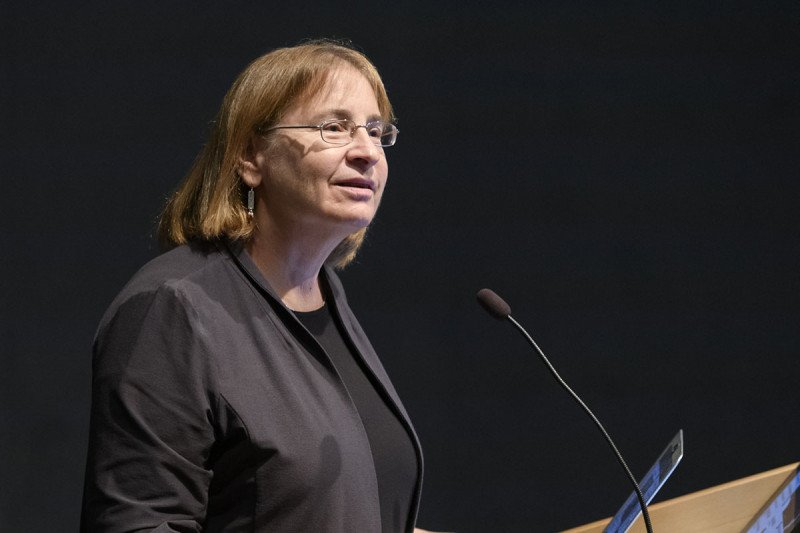
Sometimes the best way to understand a biological process is to disrupt the normal process and analyze the result.
That’s why Sloan Kettering Institute (SKI) researchers used a strain of mutant mice as a means to uncover new clues about the process of meiosis, which forms eggs and sperm (also known as germ cells). The investigators learned how breaks in DNA can lead to unanticipated types of harmful mutations. Understanding how mutations arise in germ cells is important because they can cause miscarriages and genetic diseases. The research was published November 17, 2021, in Cell.
“This research has enabled us to learn more about meiosis at the molecular level,” says first author Agnieszka Lukaszewicz, a senior research scientist working in the lab of Maria Jasin, a member in SKI’s Developmental Biology Program. “We have new insights about what happens when something goes wrong.”
Managing DNA Breaks to Prevent Errors
Thanks to meiosis, children inherit an equal amount of genetic material from each parent. But each sperm or egg cell contains only half of the parent’s DNA. After an egg is fertilized, the two halves come together to create an embryo with a full set of chromosomes.
A crucial part of meiosis occurs when both strands of DNA break in the same place and then are repaired by a process called recombination. About 300 of these double-strand breaks occur around the genome during the normal formation of egg and sperm cells. The breaks ensure that the parents’ DNA can be halved, while also resulting in genetic variation in the offspring.
“There are already a huge number of double-strand breaks that occur during meiosis,” says Dr. Jasin, the study’s senior author. “The important finding here is that when there are too many double-strand breaks, they may not be repaired properly, leading to potentially severe mutations that can be transmitted to the offspring.”
This research has enabled us to learn more about meiosis at the molecular level.
An Accumulation of Damage
In the new research, the team focused on male mice that were missing a gene called ATM. Mutations in ATM are associated with cancer, because they prevent cells from being able to recognize that they have damaged DNA, allowing many more mutations to accumulate.
In this case, mice with no ATM had germ cells with more than 10 times more double-strand breaks in their DNA, compared with what would occur during normal meiosis. The team then looked at how those breaks were repaired or — more likely — misrepaired.
Double-strand breaks that happen in DNA during meiosis are usually repaired by homologous recombination, a process that occurs when the damaged DNA finds the matching genetic sequence and brings the two sequences together. This helps in dividing the chromosomes’ content. But in the mice missing ATM, breaks were found to be repaired by an alternate, less accurate process. In this process, termed nonhomologous end joining, the broken DNA ends are simply stitched back together. Because so many more breaks are formed to begin with when ATM is missing, DNA ends from two breaks may be stitched together. This leads to errors like deletions and duplications of genetic material.
“A lot of meiosis research has been done in yeast, where homologous recombination is the dominant repair process,” Dr. Jasin says. “But mice — and people — commonly use nonhomologous means to repair broken DNA.” By studying this process in mice with a genetic defect leading to abnormally high DNA breaks in meiosis, the investigators were able to learn more about the consequences of these extra breaks.
Each of the investigators on the study, including Dr. Jasin’s long-term collaborator in meiosis research, Scott Keeney in SKI’s Molecular Biology Program, emphasize that further work needs to be done, because loss of one copy of the ATM gene is not uncommon in human populations. It remains to be seen whether that will result in higher mutation rates.
Understanding how deletions and duplications of genetic material arise is important because if these errors occur within genes that are essential for healthy development, they can lead to miscarriage. If the errors occur in genes that are not essential but nonetheless important, they can still cause damage, including genetic diseases.
Looking at the big picture, the study results have implications for explaining how genetic changes evolve over many generations, because mutations in nonessential genes, as well as in noncoding DNA regions containing regulatory elements, shape a person’s genetic makeup.
Key Takeaways
- SKI researchers used a strain of mutant mice as a means to uncover new clues about the process of meiosis, which forms eggs and sperm (also known as germ cells).
- By studying this process in mice with a genetic defect leading to abnormally high DNA breaks in meiosis, the investigators were able to learn more about the consequences of these extra breaks.
- These kinds of errors can lead to genetic diseases and miscarriages.
"occur" - Google News
November 17, 2021 at 12:00PM
https://ift.tt/3FkIL4o
Sloan Kettering Institute Researchers Discover One Way Genetic Mutations Occur During Formation of Eggs and Sperm - On Cancer - Memorial Sloan Kettering
"occur" - Google News
https://ift.tt/2UoDqVw
https://ift.tt/2Wq6qvt
Bagikan Berita Ini















0 Response to "Sloan Kettering Institute Researchers Discover One Way Genetic Mutations Occur During Formation of Eggs and Sperm - On Cancer - Memorial Sloan Kettering"
Post a Comment